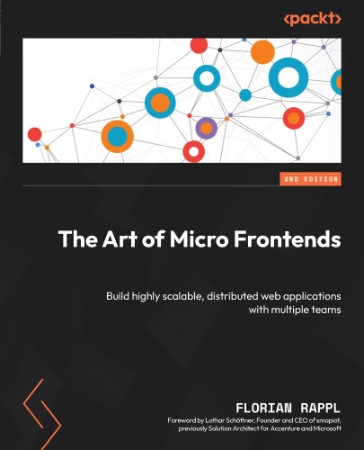Most Commented
The Art of Micro Frontends - Second Edition: Build highly scalable




Description material

epub | 12.65 MB | English| Isbn:9781835460351 | Author: Florian Rappl, Lothar Schïttner (Foreword by) | Year: 2024
Description:
Apply your web development experience with HTML and jаvascript to build micro frontends for large-scale web projects, independent of frameworks and tooling
Key Features
Cut through the complexities of designing a monolithic web architecture using micro frontend architecture
Explore architecture patterns and their areas of use for building large-scale applications
Learn how to build, test, and secure your micro frontends efficiently
Purchase of the print or Kindle book includes a free PDF eBook
Book Description
The organizational pattern of micro frontends allows you to split web applications into multiple parts, where each part can be owned by an autonomous team. Each team can have its own development and deployment life cycle, allowing every part of an application to be shipped in isolation. Following the strategies outlined in this book, you can avoid complexity while increasing resilience for your frontend. This updated second edition will guide you through the patterns available to implement a micro frontend solution. You'll learn about micro frontends, the different architecture styles, and their areas of use. Then, you'll learn how to prepare teams for the change to micro frontends, as well as how to adjust the user interface (UI) design and your CSS styles for scalability. Starting with the simplest variants of micro frontend architectures, the book progresses from static approaches to fully dynamic solutions that allow maximum scalability with faster release cycles. In the concluding chapters, you'll strengthen the security level of your micro frontend solution, while reinforcing your overall knowledge with real-world case studies relating to micro frontends. By the end of this book, you'll be able to decide whether and how micro frontends should be implemented to achieve high scalability for your web app.
What you will learn
Understand how to choose the right micro frontend architecture
Use screen designs and isolated styles for compositional UIs
Create outstanding developer experiences for micro frontend solutions
Introduce governance and boundary checks to manage distributed frontends
Share dependencies and expose micro frontends with module federation
Build scalable modular web applications from scratch or by migrating an existing monolith
Who this book is for
This book is for software architects, lead developers, senior web developers, and frontend engineers. Beginner-level knowledge of HTML and CSS, as well as a solid understanding of jаvascript programming and its ecosystem, including Node.js and npm, is assumed.
Key Features
Book Description
The organizational pattern of micro frontends allows you to split web applications into multiple parts, where each part can be owned by an autonomous team. Each team can have its own development and deployment life cycle, allowing every part of an application to be shipped in isolation. Following the strategies outlined in this book, you can avoid complexity while increasing resilience for your frontend. This updated second edition will guide you through the patterns available to implement a micro frontend solution. You'll learn about micro frontends, the different architecture styles, and their areas of use. Then, you'll learn how to prepare teams for the change to micro frontends, as well as how to adjust the user interface (UI) design and your CSS styles for scalability. Starting with the simplest variants of micro frontend architectures, the book progresses from static approaches to fully dynamic solutions that allow maximum scalability with faster release cycles. In the concluding chapters, you'll strengthen the security level of your micro frontend solution, while reinforcing your overall knowledge with real-world case studies relating to micro frontends. By the end of this book, you'll be able to decide whether and how micro frontends should be implemented to achieve high scalability for your web app.
What you will learn
Who this book is for
This book is for software architects, lead developers, senior web developers, and frontend engineers. Beginner-level knowledge of HTML and CSS, as well as a solid understanding of jаvascript programming and its ecosystem, including Node.js and npm, is assumed.
Warning! You are not allowed to view this text.
Warning! You are not allowed to view this text.
Warning! You are not allowed to view this text.
Warning! You are not allowed to view this text.
Join to our telegram Group
Information
Users of Guests are not allowed to comment this publication.
Users of Guests are not allowed to comment this publication.
Choose Site Language
Recommended news
Commented



![eM Client Pro 9.2.1735 Multilingual [Updated]](https://pikky.net/medium/wXgc.png)





![[PORTABLE] Pixarra TwistedBrush Paint Studio 4.15](https://i.postimg.cc/C1HNvfVk/Pixarra-Twisted-Brush-Paint-Studio.jpg)
![Movavi Video Editor 24.0.2.0 Multilingual [ Updated]](https://pikky.net/medium/qhrc.png)

